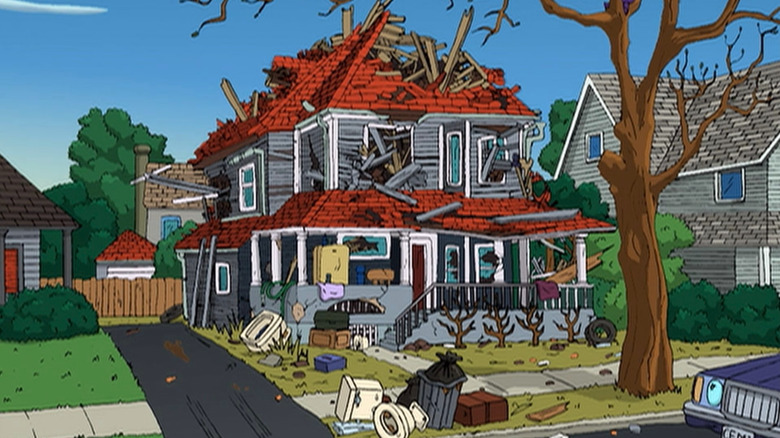Why Fry's Childhood Home In Futurama Means More Than You Think
The world of "Futurama" is a vast one, to say the least. While creator Matt Groening successfully crafted the town of Springfield into the hustling, bustling city of comedic characters we know it as today from his long-running series, "The Simpsons," it was probably a tall task to craft a believable futuristic society for his second, more cosmic cartoon. From the tiny details of how each robot functions to the grand scaled designs of the various planets our heroes travel to, no stone was left unturned in making New New York and the many other worlds of "Futurama" feel like living, breathing places.
Groening is infamous for hiding ultra-specific details within his shows. As a result, it isn't all that surprising that fans spend so much time digging into the sci-fi comedy's biggest Easter eggs. Much of the writing team on the Emmy-winning series actually carry PhDs and other degrees in various mathematical and scientific studies, adding a level of credibility to some of the seemingly outlandish scientific elements the show presents. But some of the most noteworthy details within "Futurama" are some of its most simple, including one regarding the childhood home of the show's protagonist, Philip J. Fry (Billy West).
Fry's home was inspired by a key Futurama crew member
"The Simpsons" and "Futurama" creator Matt Groening is infamous for hiding ultra-specific details within his shows. As a result, it isn't all that surprising that fans spend so much time digging into the sci-fi comedy's biggest Easter eggs. In a 2012 blog by Bklyner, it was discovered that the house that Philip J. Fry once resided in with his family during the 20th century was based on the real-life childhood home of one of the show's writers, Eric Kaplan.
Fry's home first appears prominently in the saddest "Futurama" episode that isn't "Jurassic Bark." In Season 3, Episode 10 ("Luck of the Fryish"), Fry, Bender (John DiMaggio), and Leela (Katey Sagal) return to the remnants of the home to retrieve Fry's lucky seven-leaf clover. Notably, the house featured in the show resembles Kaplan's original Brooklyn home to a tee, outside of the obvious dilapidated condition.
According to Realtor, the seven-bedroom, three-bathroom home was most recently placed on the market in mid-2018, when it sold for $1.5 million. Images online reveal the beautiful interior of the home that, in the show, was largely renovated for a bomb shelter designed by Fry's paranoid father, Yancy (DiMaggio). While we're not entirely sure how Kaplan felt seeing his childhood home appear in animated form, something tells us he didn't have any hard feelings about it. In fact, Kaplan has previously admitted that "Futurama" was "written from a point of view of love ... and in some kind of shmoopy way, the audience picks up on that" (via What's in My Head Podcast).

